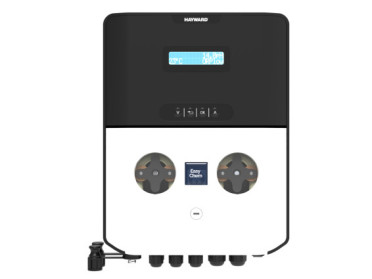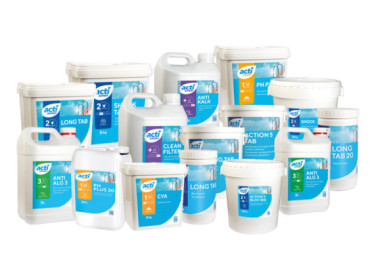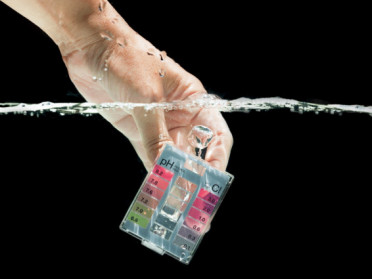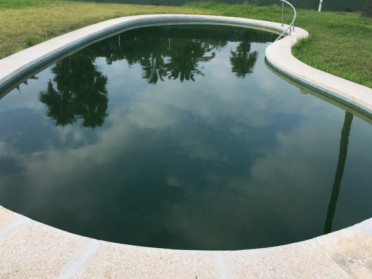
Algae: What Swimming Pool Owners Need to Know
Category : Maintenance
There is nothing quite like looking out over the sparkling blue water in your swimming pool. But every now and then, you see something in your pool that shouldn’t be there: algae.
When you see algae in your swimming pool, it’s the first indicator that something has gone wrong. Luckily, it’s easy to identify and control algae outbreaks in your pool.
What Is Algae?
The first thing you should know about algae is that it comes in two forms: black algae and free-floating algae. Each type of algae presents itself in unique ways and requires specific elimination methods.
- Free-floating algae: Green and mustard algae fall into this group. Mustard algae, which is yellowish in color, loosely clings to the walls of your pool, and you can brush it away easily. On the other hand, you can find green algae in the water throughout your pool. And depending on how serious the infestation is, the algae will turn your pool water various shades of green.
- Black algae: This type of algae grows on localized pool surfaces such a wall or in the deep end. If you find it around obstacles such as the pool’s stairs, corners, and steps, it’s likely due to poor circulation and poor sanitization.
Algae Prevention is Key
It’s much easier to prevent algae in your pool than it is to try and eradicate it once it has occurred. And the best way to prevent both types of algae is to use a quality algaecide during your regular maintenance program and ensure proper circulation in your pool.
Your pool must be properly sanitized to prevent to prevent algae from growing in your pool. But sometimes, through no fault of your own, your sanitization program fails. For instance, during a hard rain, chlorine or bromine levels can dissipate quickly. And if the equipment fails or someone makes an error when treating the pool with chemicals, it can result in algae. This improper water balance provides the ideal environment for algae growth. And if you don’t regularly use algaecide, that growth can occur in as little as a few hours. But if it’s present, it will act as an algae growth inhibitor until you can balance your water levels.
What to Do When You Spot Algae in Your Pool
No matter how hard you work at preventing algae in your swimming pool, sometimes it happens. And when it does, you need to approach it with a plan. When you know you need to use an algaecide to rid your pool of algae, first consider the following factors before you begin treatment.
How Much Algae is There?
When it comes to treating algae, less is not more. If you don’t have a good idea of how much algae is in your pool and you haphazardly treat it, it may not do much good. To properly use an algaecide, you must first determine how much algae exists in your pool, and then follow the direction on the package. In other words, treat the algae fully, based on the amount, to truly get rid of it.
How Long has the Algae Been There?
The sooner you can catch the algae and treat it, the better. That’s because it’s more difficult to treat algae that’s been in your pool for some time. It’s a good idea to check for algae as you do your pool maintenance, and once you spot it, treat it immediately.
What Kind of Day Is It?
It’s more effective to treat algae when it’s actively growing and that happens during sunny days and with warm water temperature. If the sun is out, check your water temperature, and if it’s at least 15 degrees, it’s the right time to treat the algae.
What Kind of Algae Is It?
You know about the various types of algae, but did you know that you treat each one differently? Here’s a quick guide that shows you how to treat each type.
How to Treat Green Algae
Green algae is the most common type of algae found in swimming pools. And it’s quick to grow: any lack of sanitization in your pool is an opening for green algae to form. And once it begins, it can quickly infest your swimming pool.
Heavy rains are one such entryway into your pool. After a rain, green algae can suddenly appear in your pool, even though it was perfectly clear the day before. That’s because rainstorms feed algae with nitrogen, which also destroys chlorine residuals.
Did You Know?
Metals, like copper can also give your swimming pool water a green tint. It’s important that you don’t mistake green algae for metals.
When it comes to treating green algae, your best bet is prevention. By using a good algaecide in your regular pool maintenance program, you can prevent green algae from growing, even if a rainstorm hits or you make a mistake in your sanitizing program. Remember, it’s much easier to prevent green algae from growing than it is to treat it.
But if you do spot green algae in your pool, don’t wait to treat it. Instead, use an algaecide that kills the existing algae and also prevents renewed growth. Be sure to follow the instructions on the label and ensure that your pool has proper circulation.
How to Treat Mustard Algae
If your pool has mustard or yellow algae, you’ll know it by its color. Because this type of algae is deficient in chlorophyll (which is a green pigment), it is easy to spot. You can also tell this type of algae because of how easy it is to brush away from pool walls and floors. And although yellow or mustard algae grows slower than green algae, it’s not easy to destroy.
Here’s the thing: by the time you spot this type of algae growing in your pool, it’s probably already been there for up to several weeks. And because these algae live in dark places of your pool like the filters and plumbing fixtures, it can be hard to see—and control.
If you need to treat yellow or mustard algae, it’s important to use an algaecide that is specifically formulated to treat this type—a copper-based algaecide is recommended. But because this type of algae is so difficult to control, you may have to treat it more than once to finally rid your pool of it.
How to Treat Black Algae
If you thought yellow or mustard algae was difficult to control, meet black algae. It’s considered the most difficult algae to kill because it actually protects itself from your efforts. It does this by developing specialized cells that penetrate deeply into the pores of your pool’s surfaces—even chlorine can’t penetrate into these deep pores. And if that’s not enough, black algae also form an outer layer consisting of a waxy coat that keeps chlorine or even an algaecide from penetrating it.
That’s why it’s so important to prevent black algae from ever growing in your pool with an algaecide specifically designed for it.
So, how do you kill these stealthy algae if it appears in your pool?
Start by purchasing an algaecide with a penetrating agent. That’s because unless you kill all of its cells, the algae will only grow back. The penetrating agent will penetrate the deep pores of the pool’s surface and cut through the algae’s waxy coat with a wetting action that doesn’t exist in chlorine.
You also need to be aware of your pool’s circulation, and if there are areas that aren’t sufficient, they will need to be corrected. When an area of your pool doesn’t get enough circulation, fresh water, algaecide, or sanitizer can’t get to it with any regularity. And these areas are where black algae usually begins to grow.
If you need to bring black algae under control in your pool, follow these steps:
- If areas of your pool suffer from inadequate circulation, correct them.
- Using a pool brush, brush the algae colonies to break through the waxy coating that protects the algae. Don’t skip this step!
- Add an algaecide specifically formulated for black algae
- Use your pool brush to brush the algae colony every day. This will remove any dead surface cells and expose the underlying ones. And that will allow the penetrating algaecide to kill them.
Remember, your pool professional is the best source for questions when algae develop in your swimming pool. If you are unsure how to treat an infestation, be sure to call them for professional advice.
Related Products
More Maintenance Tips
Maintenance
Opening Your Pool: An Easy to Follow Guide
When spring is finally here and as the temperatures begin to climb, it’s time to think about getting the pool area ready for the warm weather. Opening a pool is now easier than ever and with a few simple steps, you can be ready to enjoy your pool in no time!

Maintenance
Pool Care Basics: Pool Water Info and Tips
You can transform your backyard from a boring patch of land to a luxurious retreat with one exciting addition—a swimming pool! Of course, swimming pools aren’t all fun and games. You need to know how to maintain your pool in order to keep it sparkling clean.






